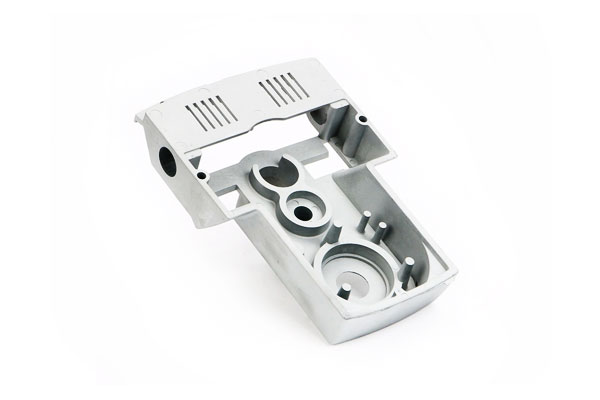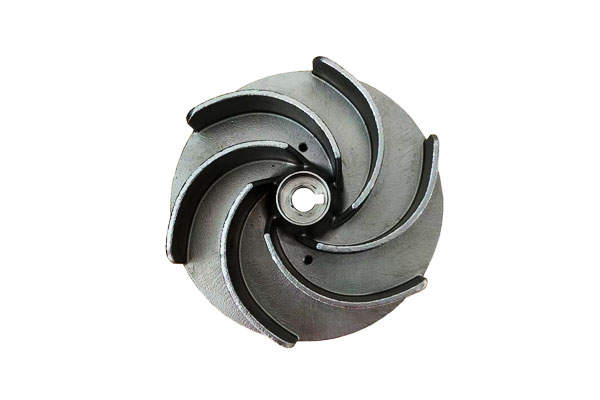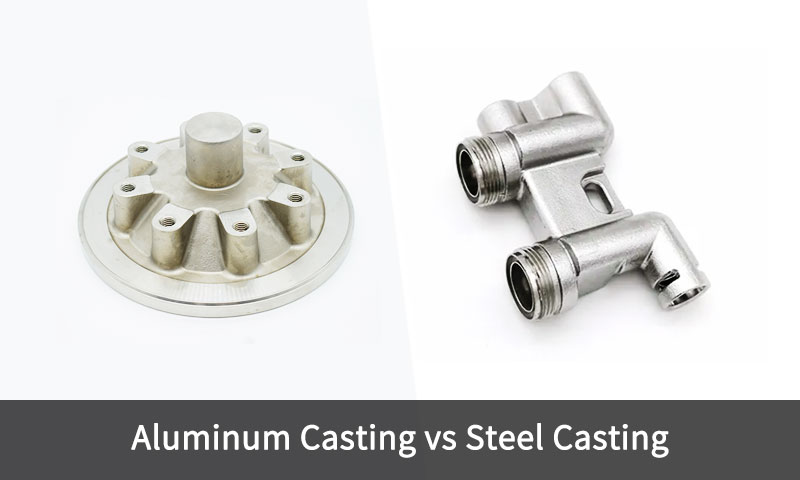1. Perkenalan
Aluminum vs Steel Casting — choosing between these two foundational materials shapes component performance, cost and manufacturability across industries from automotive to energy.
This comparison is not merely about metal chemistry: it encompasses density and stiffness, perilaku termal, casting process compatibility, secondary processing (perlakuan panas, Rekayasa Permukaan), lifecycle cost and application-specific reliability.
Engineers and purchasers must therefore evaluate the entire system—loading, suhu, environment, production volume and finish requirements—before specifying a metal and casting route.
2. Fundamental Material Differences Between Aluminum vs Steel
At the core of aluminum vs. steel casting lies a fundamental metallurgical and physical contrast that directly affects how each material behaves during casting, pemesinan, dan layanan.
| Milik | Aluminium (MISALNYA., Al-i tetap saja) | Baja (MISALNYA., carbon or low-alloy steels) | Implikasi Rekayasa |
| Kepadatan (g/cm³) | 2.70 | 7.85 | Aluminum is ~65% lighter, offering major weight savings for transportation and aerospace. |
| Titik lebur (° C.) | 615–660 | 1425–1540 | Aluminum’s low melting point enables easier casting and lower energy consumption; steel requires specialized furnaces. |
| Konduktivitas termal (W/m · k) | 120–180 | 40–60 | Aluminum dissipates heat efficiently—ideal for engines, Penukar panas, dan elektronik. |
| Kekuatan spesifik (MPa/ρ) | ~100–150 | ~70–90 | Despite lower absolute strength, aluminum’s strength-to-weight ratio surpasses that of steel. |
| Modulus elastis (IPK) | 70 | 200 | Steel is stiffer, providing better rigidity under load and vibration. |
Resistensi korosi |
Bagus sekali (forms Al₂O₃ layer) | Variabel; prone to rust without coatings | Aluminum resists oxidation naturally, while steel needs surface protection (lukisan, pelapis, or alloying with Cr/Ni). |
| Kemampuan mesin | Bagus sekali | Sedang hingga sulit | Aluminum’s softness allows easy machining and shorter cycle times; steel requires tougher tooling. |
| Daur ulang | >90% recoverable | >90% recoverable | Both materials are highly recyclable, though aluminum’s remelting requires less energy (5% of primary production). |
| Casting Shrinkage (%) | 1.3–1.6 | 2.0–2.6 | Steel shrinks more during solidification, demanding larger allowances and more complex gating/feeding systems. |
| Biaya (kira -kira., USD/KG) | 2.0–3.0 | 0.8–1.5 | Aluminum is more expensive per kilogram, but savings in weight and processing can offset total lifecycle costs. |
3. What Is Aluminum Casting?
Aluminium pengecoran is the process of shaping molten aluminum or aluminum alloys into complex, near-net-shape components using molds.
It is one of the most widely used metal casting processes globally—accounting for over 50% of all nonferrous castings—due to aluminum’s excellent castability, kepadatan rendah, dan resistensi korosi.

Ringkasan
In aluminum casting, aluminium cair (biasanya antara 680–750°C) is poured or injected into a mold cavity where it solidifies into the desired geometry.
Aluminum’s low melting point and high fluidity make it ideal for both mass-production methods (like die casting) Dan Aplikasi presisi tinggi (like investment casting).
Key Features of Aluminum Casting
- Rasio yang ringan dan berkekuatan tinggi:
Aluminum castings offer excellent mechanical performance while being about sepertiga berat baja. - Resistensi korosi yang baik:
Tipis, penyembuhan diri sendiri Lapisan aluminium oksida (Al₂o₃) protects against oxidation and most atmospheric or marine corrosion. - Konduktivitas termal dan listrik yang sangat baik:
Suitable for applications like Penukar panas, perumahan, and electric components. - Daur ulang:
Aluminum can be recycled indefinitely without degradation, reducing production energy by up to 95% compared to primary smelting.
Common Aluminum Casting Processes
| Metode casting | Keterangan | Aplikasi khas |
| pengecoran mati | High-pressure injection of molten aluminum into steel dies; yields precise, bagian berdinding tipis. | Bagian otomotif (Perumahan Perlengkapan, kurung), Elektronik Konsumen. |
| Casting pasir | Molten metal poured into sand molds; suitable for larger, lower-volume parts. | Blok mesin, manifold, perumahan dirgantara. |
| Pengecoran Investasi | Ceramic molds from wax patterns; ideal for fine details and tight tolerances. | Komponen turbin aerospace, alat kesehatan. |
| Casting cetakan permanen | Reusable metal molds; good surface finish and dimensional control. | Piston, roda, dan komponen kelautan. |
| Casting sentrifugal | Uses centrifugal force to distribute molten metal; padat, struktur bebas cacat. | Tabung, lengan, and rings. |
Keuntungan casting aluminium
- Ringan: Reduces component weight by 30–50% vs.. baja, improving fuel efficiency (otomotif) or payload capacity (Aerospace).
- Efisiensi Energi: Melting aluminum requires 60–70% less energy than steel (570° C vs.. 1420° C.), lowering processing costs by 20–30%.
- Resistensi korosi: Eliminates the need for coatings (MISALNYA., cat, galvanis) di sebagian besar lingkungan, reducing maintenance costs by 40–50%.
- High-Volume Viability: Die casting enables production of 1000+ parts/day per machine, meeting consumer goods demand.
Disadvantages of Aluminum Casting
- Kekuatan yang lebih rendah: Kekuatan tarik (150–400 MPa) is 50–70% lower than high-strength steel, limiting use in heavy-load applications.
- Poor High-Temperature Performance: Retains only 50% of room-temperature strength at 250°C, making it unsuitable for engine exhaust or power plant components.
- Risiko porositas: Die-cast aluminum is prone to gas porosity (from high-pressure injection), restricting heat treatment options (MISALNYA., T6 temper requires vacuum processing).
- Higher Raw Material Cost: Primary aluminum costs $2,500–$3,500/tonne, 2–3x more than carbon steel.
Industrial Applications of Aluminum Casting
Aluminum casting is widely used across multiple industries due to its combination of Desain ringan, kemampuan mesin, dan resistensi korosi:
- Otomotif: Blok mesin, rumah transmisi, roda, and suspension arms.
- Luar angkasa: Kurung, perlengkapan struktural, rumah kompresor.
- Elektronik: Heat sink, rumah motor, penutup.
- Barang konsumen: Peralatan, Perangkat Daya, Perangkat keras furnitur.
- Marine and Renewable Energy: Baling -baling, perumahan, dan bilah turbin.
4. What Is Steel Casting?
Steel casting is the process of pouring molten steel into a mold to produce complex, high-strength components that cannot be easily fabricated or forged.
Unlike aluminum, steel has a titik leleh yang lebih tinggi (≈ 1450–1530°C) and greater tensile strength, membuatnya ideal untuk load-bearing and high-temperature applications such as machinery, infrastructure, dan pembangkit listrik.

Ringkasan
In steel casting, carefully alloyed molten steel is poured into either expendable (pasir, investasi) or permanent molds, where it solidifies into a shape close to the final part.
Because steel shrinks significantly upon cooling, precise temperature control, Desain gating, and solidification modeling sangat penting.
Steel castings are known for their Ketahanan mekanis, Dampak resistensi, dan integritas struktural, particularly under harsh service conditions.
Key Features of Steel Casting
- Exceptional Strength and Toughness:
Yield strengths often exceed 350 MPa, with heat-treated alloys reaching over 1000 MPa. - High-Temperature Capability:
Retains strength and oxidation resistance up to 600–800°C, depending on composition. - Versatile Alloy Selection:
Includes Baja karbon, Baja paduan rendah, Baja tahan karat, and high-manganese steels, each tailored for specific environments. - Kemampuan las dan kemampuan mesin:
Cast steels can be post-processed effectively—machined, lasan, and heat-treated to enhance performance.
Common Steel Casting Processes
| Metode casting | Keterangan | Aplikasi khas |
| Casting pasir | Molten steel poured into bonded sand molds; ideal untuk besar, bagian yang kompleks. | Tubuh katup, selongsong pompa, machinery housings. |
| Pengecoran Investasi | Ceramic molds formed from wax patterns; yields excellent accuracy and surface finish. | Bilah turbin, alat bedah, Bagian Aerospace. |
| Casting sentrifugal | Rotational force distributes molten steel evenly; produces dense cylindrical components. | Pipa, liner, Balapan bantalan. |
| Casting cetakan cangkang | Uses thin resin-coated sand molds; allows higher precision and smoother surfaces. | Bagian mesin kecil, kurung. |
| Casting terus menerus | For semi-finished steel products like slabs and billets. | Raw material for rolling and forging. |
Advantages of Steel Casting
- Superior Strength & Kekerasan: Kekuatan tarik (hingga 1500 MPa) dan dampak ketangguhan (40–100 j) make it irreplaceable for structural safety (MISALNYA., komponen jembatan, Sasis otomotif).
- Kinerja suhu tinggi: Operates reliably at 400–600 ° C. (vs.. aluminum’s 250°C limit), suitable for jet engine casings and power plant boilers.
- Low Raw Material Cost: Carbon steel costs $800–$1200/tonne, 60–70% less than primary aluminum.
- Pakai ketahanan: Heat-treated steel (MISALNYA., 4140) has surface hardness up to 500 HB, reducing replacement frequency in abrasive applications by 50–70%.
Disadvantages of Steel Casting
- High Weight: Density 2.7x that of aluminum increases fuel consumption (otomotif) or structural load (buildings).
- High Energy Use: Melting steel requires 25–30 MWh/tonne (vs.. 5–7 MWh/tonne for aluminum), increasing processing costs by 40–50%.
- Kerentanan korosi: Carbon steel rusts in moist environments (laju korosi: 0.5–1.0 mm/tahun in salt spray), requiring coatings (MISALNYA., galvanis) that add $1.5–$2.5/kg to costs.
- Poor Machinability: Hardness requires specialized tools, meningkatkan waktu pemesinan oleh 30–50% vs.. aluminium.
Industrial Applications of Steel Casting
Steel castings dominate industries demanding kekuatan, daya tahan, dan ketahanan panas:
- Konstruksi & Pertambangan: Excavator teeth, bagian crusher, track links.
- Energi & Pembangkit listrik: Steam turbine casings, tubuh katup, komponen nuklir.
- Minyak & Gas: Drill heads, pipeline valves, manifold.
- Angkutan: Train couplers, Perumahan Perlengkapan, heavy-duty engine blocks.
- Luar angkasa & Pertahanan: Landing gear, perlengkapan struktural, armor components.
5. Perbandingan komprehensif: Pengecoran Aluminium vs Baja
Process fit and part geometry
- Berdinding tipis, kompleks, Bagian volume tinggi: aluminum die casting is optimal (HPDC).
- Besar, berat, load-bearing parts: steel/spheroidal graphite (Dukes) iron and cast steels via sand casting are preferred.
- Medium volume with high integrity requirements: low-pressure aluminum or investment casting steels depending on strength needs.
Mechanical performance & pasca-pemrosesan
- Perlakuan panas: cast steel can be quenched & tempered to obtain high strength and toughness; aluminum alloys have age-hardening routes but reach lower maximum strengths.
- Surface engineering: aluminum readily anodizes; steel can be nitrided, carburized, induction hardened or coated with hard substances (keramik, hard chrome).
Pengemudi Biaya (typical considerations)
- Material cost per kg: aluminum raw metal tends to be priced higher per kg than ferrous scrap/steel, but part mass reduces required amount.
- Perkakas: die casting dies are expensive (high initial amortization) but low per-part cost at volumes >10k–100k; sand tooling is cheap but per-part labor higher.
- Pemesinan: aluminum machines faster (higher removal rates), lower tool wear; steel requires harder tooling and more machining time—raises total cost especially for small batches.
Manufaktur & defect modes
- Porositas: HPDC aluminum can develop gas and shrinkage porosity; permanent-mold and low-pressure reduce porosity.
Steel castings can suffer inclusions and segregation; controlled melting and post-HT reduce defects. - Kontrol dimensi: die cast aluminum attains tight tolerances (± 0,1-0,3 mm); sand cast steel tolerances are looser (±0.5–2 mm) without post-machining.
Lingkungan & life-cycle
- Daur ulang: both metals are highly recyclable. Recycled aluminum uses a small fraction (~5–10%) of the energy of primary smelting; recycled steel also has large energy savings compared to virgin iron.
- Use-phase: lightweight aluminum can reduce fuel consumption in vehicles — a system-level environmental benefit.
Meja: Aluminum vs Steel Casting — Key Technical Comparison
| Kategori | Casting aluminium | Pengecoran baja |
| Kepadatan (g/cm³) | ~2.70 | ~7.80 |
| Titik lebur (° C. / ° f) | 660° C. / 1220° f | 1450–1530 ° C. / 2640–2790°F |
| Kekuatan (Tarik / Menghasilkan, MPa) | 130–350 / 70–250 (as-cast); hingga 500 setelah perlakuan panas | 400–1200 / 250–1000 (Tergantung pada kadar dan perlakuan panas) |
| Kekerasan (HB) | 30–120 | 120–400 |
| Modulus elastis (IPK) | 70 | 200 |
| Konduktivitas termal (W/m · k) | 150–230 | 25–60 |
| Konduktivitas Listrik (% IACS) | 35–60 | 3–10 |
| Resistensi korosi | Bagus sekali (Lapisan oksida alami) | Variable — requires alloying (Cr, Di dalam, Mo) atau lapisan |
| Resistensi oksidasi (High-Temp) | Terbatas (<250° C.) | Bagus hingga bagus (up to 800°C for some alloys) |
| Kemampuan mesin | Bagus sekali (lembut, easy to cut) | Sedang sampai miskin (lebih sulit, kasar) |
| Kemampuan cast (Ketidakstabilan & Penyusutan) | Fluiditas tinggi, penyusutan rendah | Lower fluidity, higher shrinkage — needs precise gating |
| Keuntungan Berat Badan | ~65% lighter than steel | Heavy — suitable for structural loads |
Permukaan akhir |
Mulus, good detail reproduction | Rougher surfaces; may need machining or shot blasting |
| Heat Treatment Flexibility | Bagus sekali (T6, T7 tempers) | Luas (anil, pendinginan, tempering, menormalkan) |
| Daur ulang | >90% recycled efficiently | >90% recyclable but requires higher remelting energy |
| Production Cost | Lower energy, waktu siklus yang lebih cepat | Higher melting cost and tool wear |
| Toleransi khas (mm) | ±0.25 to ±0.5 (pengecoran mati); ±1.0 (casting pasir) | ±0.5–1.5 depending on process |
| Environmental Footprint | Rendah (especially recycled aluminum) | Higher CO₂ and energy footprint due to high melting point |
| Aplikasi khas | Roda otomotif, perumahan, Bagian Aerospace, barang konsumen | Katup, turbin, mesin berat, komponen struktural |
6. Kesimpulan
Aluminum and steel castings solve different engineering problems.
Aluminum excels where Berat ringan, konduktivitas termal, surface quality and high production rates matter.
Baja (and cast irons) dominate where kekuatan tinggi, kekakuan, Pakai ketahanan, toughness and elevated temperature performance diperlukan.
Good material selection balances functional requirements, biaya (total life cycle), producibility and finishing.
In many modern designs hybrid solutions appear (steel inserts in aluminum castings, clad or bimetallic components) to exploit the strengths of both metals.
FAQ
Yang lebih kuat: cast aluminum or cast steel?
Cast steel is significantly stronger—A216 WCB steel has a tensile strength of 485 MPa, 67% higher than A356-T6 aluminum (290 MPa).
Steel also has far greater toughness and wear resistance.
Can cast aluminum replace cast steel?
Only in applications where weight reduction is prioritized over strength (MISALNYA., automotive non-structural parts).
Steel is irreplaceable for high-load, high-temperature components (MISALNYA., selongsong turbin).
Which is more corrosion-resistant: cast aluminum or cast steel?
Cast aluminum is more corrosion-resistant in most environments (laju korosi <0.1 mm/tahun) vs.. baja karbon (0.5–1.0 mm/tahun).
Stainless steel castings match aluminum’s corrosion resistance but cost 2–3x more.
Which casting process is best for aluminum vs. baja?
Aluminum is ideal for die casting (volume tinggi) and sand casting (berbiaya rendah).
Steel is best for sand casting (bagian besar) dan casting investasi (kompleks, high-tolerance components). Die casting is rarely used for steel.


